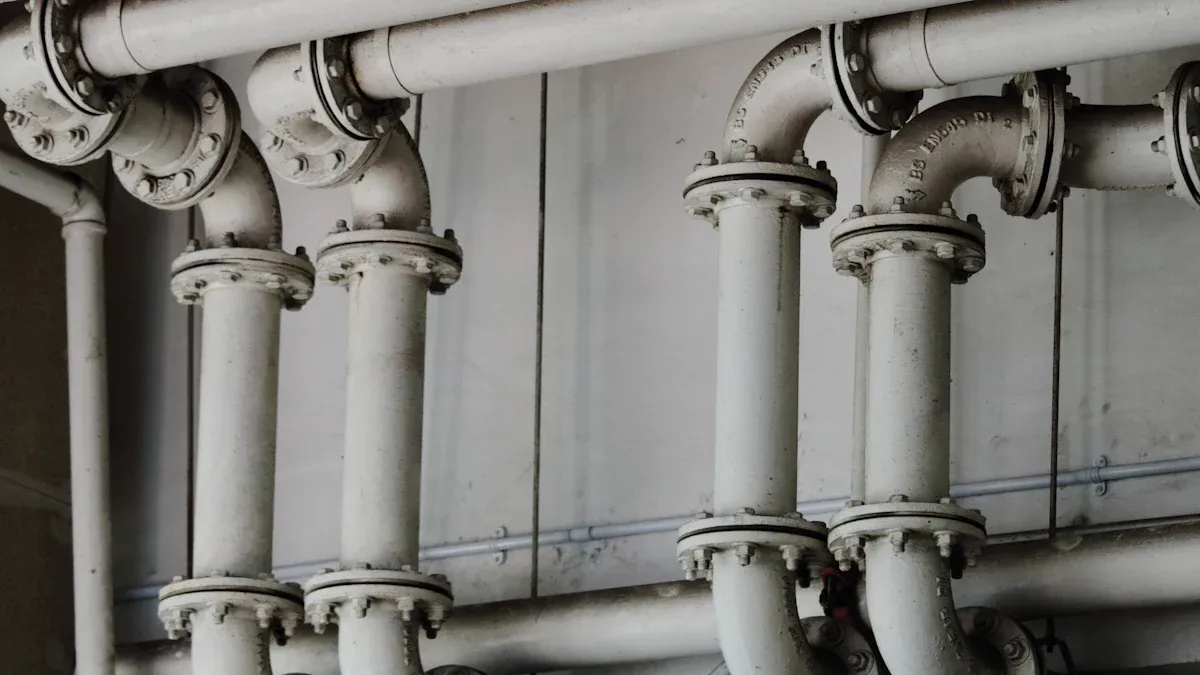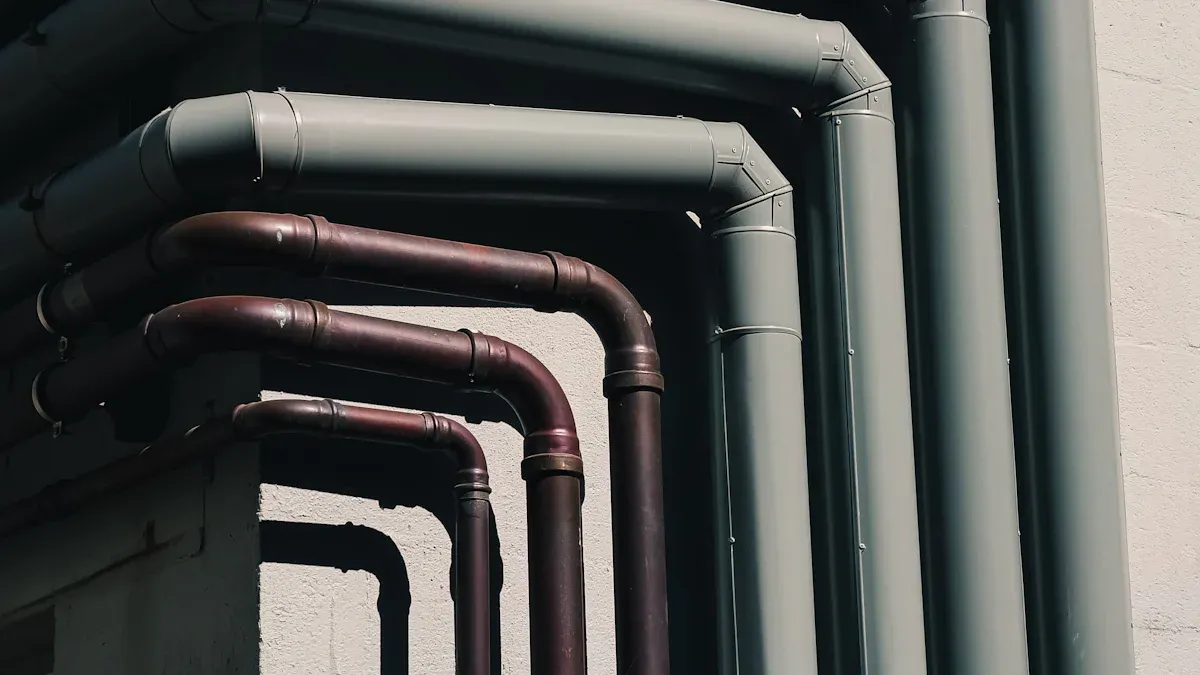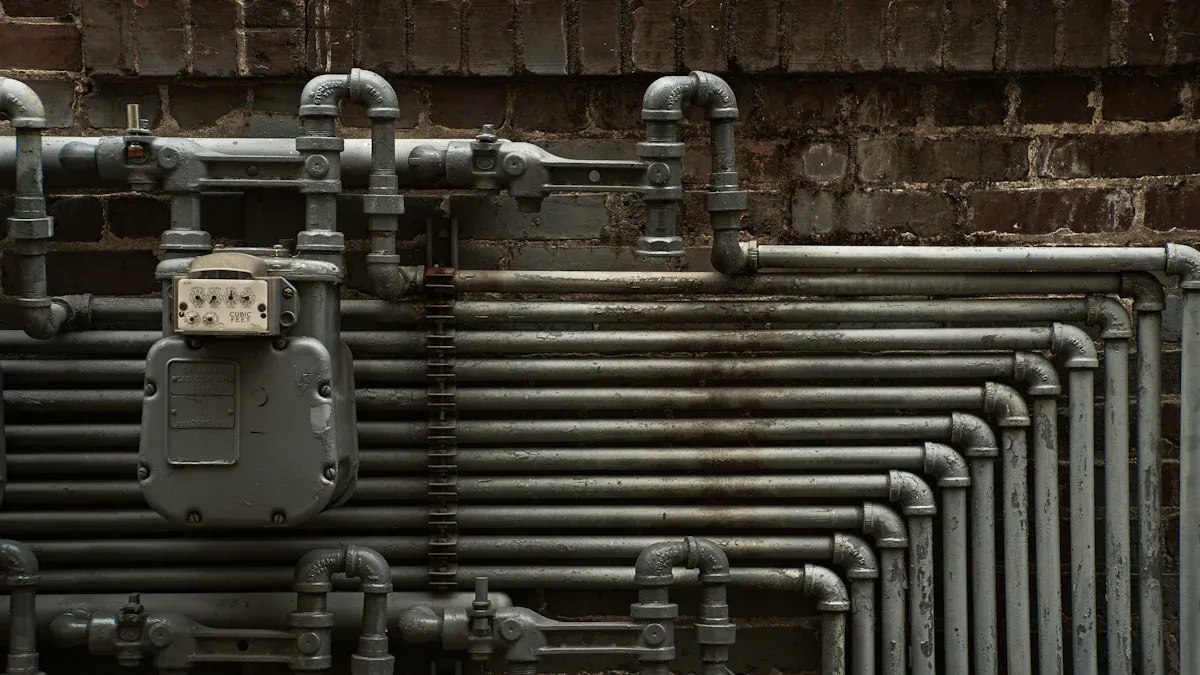
When you think about a concrete pump truck, the bend pipe might not be the first thing that comes to mind. But this small component plays a huge role in making the entire system work smoothly. It helps guide the flow of concrete through twists and turns, ensuring it reaches the right spot without any hiccups.
The bend pipe also manages pressure within the system. This prevents potential damage and keeps the operation running safely. Plus, its design helps improve durability and efficiency, which means less downtime and better performance for your projects.

When you're working on a construction site, getting concrete to the right spot can be tricky. This is where bend pipes come in. These pipes guide the flow of concrete through the twists and turns of the concrete pump pipeline. Whether you're pumping concrete to a high-rise building or a hard-to-reach corner, bend pipes make it possible. They ensure the concrete flows smoothly, even in the most complex setups. Without them, you'd face blockages or uneven distribution, which could slow down your project.
Pressure management is another critical role of bend pipes. As concrete moves through the pipeline, it creates pressure. If this pressure isn't controlled, it can damage the system. Bend pipes are designed to handle these forces, ensuring the pipeline stays intact. A study even developed a pressure loss correction model for bend sections, showing how factors like elbow shape and flow rate affect pressure loss. This model proved that optimizing bend pipes can significantly improve the performance of a concrete pump pipeline. By managing pressure effectively, bend pipes keep your equipment safe and your operations running smoothly.
Concrete is abrasive, and as it moves through the pipeline, it can cause wear and tear. Bend pipes play a big role in reducing this damage. Their curved design minimizes the impact of the concrete on the walls of the pipeline. This not only extends the life of the concrete pump pipe but also reduces maintenance costs. Plus, by preventing excessive wear, bend pipes help maintain the efficiency of the entire concrete pump pipeline. It's a small component that makes a big difference in keeping your system running for longer.
When it comes to bend pipes, the materials used can make or break their performance. Most bend pipes are made from durable metals like steel or cast iron. Steel is a popular choice because it’s strong and can handle the high pressure of pumping concrete. Some pipes even use special alloys to resist wear and tear caused by the abrasive nature of concrete.
You’ll also find pipes with protective coatings or liners. These add an extra layer of defense against damage. For example, some pipes use ceramic liners to reduce abrasion, while others rely on polyurethane for flexibility and durability. Choosing the right material ensures your bend pipes last longer and perform better on the job.
Pipe thickness and bending radius might sound technical, but they’re crucial for smooth operations. Thicker pipes can handle more pressure and resist wear better. If you’re working with high-pressure systems, thicker walls are a must.
The bending radius, or how sharply the pipe curves, also matters. A tighter bend can cause more pressure loss and wear. On the other hand, a wider radius allows concrete to flow more smoothly. By balancing these factors, you can optimize your pipeline for efficiency and durability.
The design of bend pipes isn’t just about looks—it directly affects how well they work. A well-designed pipe minimizes pressure loss and reduces the risk of blockages. For instance, smoother inner surfaces help concrete flow without interruptions.
Studies show that integrating steel pipes with prepacked aggregate concrete (PAC) can improve structural integrity. PAC’s low shrinkage and high fluidity make it ideal for construction, especially when paired with durable pipe designs. By choosing the right design, you can enhance both performance and longevity.

Concrete is tough, but it’s also abrasive. As it flows through the pipeline, it grinds against the inner walls of the bend pipes. Over time, this constant friction wears down the material. You might notice thinning walls or small cracks forming. If left unchecked, these issues can lead to leaks or even pipe failure.
To minimize wear and tear, you can choose bend pipes made from durable materials like steel or those with protective liners. Regular inspections also help you catch early signs of damage before they become major problems.
Tip: If your projects involve high-pressure concrete pumping, consider pipes with ceramic liners. They’re great at resisting abrasion and extending the lifespan of your equipment.
Even the best bend pipes won’t perform well if they’re installed incorrectly. Misaligned pipes can disrupt the flow of concrete, causing blockages or uneven pressure distribution. Improper usage, like exceeding the recommended pressure limits, can also strain the system.
To avoid these headaches, make sure your team follows the manufacturer’s guidelines during installation. Double-check connections and alignment before starting operations. Training your crew on proper usage can save you time and money in the long run.
Note: Always consult the user manual for your concrete pump truck. It’s packed with valuable information to help you avoid common mistakes.
Spotting damage early can save you from costly repairs. Look for visible cracks, dents, or thinning walls on your bend pipes. If you notice inconsistent concrete flow or unusual noises during operation, these could be signs of internal damage.
When a pipe shows significant wear, it’s time to replace it. Using damaged pipes can compromise the entire system and delay your project. Keep spare bend pipes on hand to ensure smooth operations.
Reminder: Regular maintenance checks are your best defense against unexpected failures. Set up a schedule to inspect your pipeline components every few weeks.
Keeping your concrete pump pipeline in top shape starts with regular inspections and cleaning. These simple practices can save you a lot of trouble down the road. When you inspect your system frequently, you can catch small issues before they turn into big problems. For example, cracks or thinning walls in your concrete pump pipe might seem minor at first, but they can lead to leaks or even system failure if ignored.
Cleaning is just as important. Over time, concrete residue can build up inside the pipeline, reducing flow efficiency. This buildup forces your system to work harder, which increases energy consumption and wear. By cleaning your pipes regularly, you ensure smooth concrete conveying and extend the lifespan of your equipment.
Here’s why these practices matter:
- Cost Savings: Preventing emergencies means fewer expensive repairs and less downtime.
- Enhanced System Efficiency: Clean pipes allow concrete to flow freely, reducing energy use.
- Extended Pipeline Lifespan: Well-maintained systems experience less wear and tear.
- Improved Safety: Regular checks reduce risks for your team and the environment.
- Reduced Environmental Impact: Maintenance prevents leaks, promoting responsible resource use.
Pro Tip: Schedule inspections every few weeks and clean your pipeline after each project. This routine keeps your concrete pump pipeline running smoothly.
Protective coatings and liners are game-changers when it comes to extending the life of your bend pipes. These materials act as a shield, reducing the damage caused by abrasive concrete. For instance, ceramic liners are excellent at resisting wear, while polyurethane coatings offer flexibility and durability.
Studies show that a 3 mm coating thickness provides optimal performance. With proper application, these coatings can last over 30 years, and in some cases, even up to 60 years. That’s a significant boost to your pipeline’s lifespan! Plus, coatings with strong adhesion (10.2 MPa) ensure they stay in place, even under high-pressure conditions.
| Feature | Details |
|---|---|
| Coating Thickness | 3 mm coating thickness recommended for optimal performance. |
| Adhesion Performance | 10.2 MPa, indicating strong bonding capabilities. |
| Expected Lifespan | 30+ years, with some studies suggesting up to 40-60 years. |
| Application Conditions | Material temperature at application head should be 25-35°C; substrate temperatures must be above 3°C. |
| Cure Time | 30 minutes at 30°C before the coating can be put into service. |
| Inspection | CCTV inspection recommended after a minimum cure period of 10 minutes. |
Note: Always follow the manufacturer’s guidelines when applying coatings or liners. Proper application ensures maximum protection and durability.
If you want your bend pipes to last, a few best practices can make all the difference. First, choose high-quality materials like steel or cast iron for your pipes. These materials can handle the pressure and abrasion of concrete conveying. Pipes with protective liners are also a smart investment.
Next, focus on proper installation. Misaligned pipes or loose connections can cause uneven pressure, leading to wear and tear. Make sure your team follows the manufacturer’s instructions during setup. Regular training for your crew can also help prevent common mistakes.
Scheduled inspections are another key to longevity. Research shows that regular checks can reduce the number of inspections needed over a 100-year service life. Plus, using inspection data helps you predict potential failures up to 8 years earlier. This proactive approach keeps your system running smoothly and avoids costly downtime.
Finally, don’t ignore signs of damage. If you notice cracks, dents, or inconsistent concrete flow, replace the affected pipes immediately. Keeping spare parts on hand ensures you’re always prepared for quick fixes.
Reminder: A little effort goes a long way. By combining quality materials, proper installation, and regular maintenance, you can maximize the lifespan of your concrete pump pipeline.
Choosing the right pipe for your concrete pump pipeline can feel overwhelming, but it doesn’t have to be. Start by thinking about the material. Steel pipes are a popular choice because they’re strong and handle pressure well. If you’re dealing with abrasive concrete, pipes with ceramic or polyurethane liners can offer extra protection. These materials reduce wear and tear, keeping your system running longer.
Compatibility is another big factor. Not all pipes fit every system. Check the specifications of your concrete pump pipeline to ensure the pipe you pick matches perfectly. A mismatched pipe can cause leaks or uneven flow, which slows down your project. Always double-check the dimensions and pressure ratings before making a decision.
Tip: If you’re unsure, consult the manufacturer or a trusted supplier. They can guide you toward the best option for your setup.
When it comes to concrete pump pipes, quality matters. A high-quality pipe lasts longer, performs better, and saves you money in the long run. Trusted manufacturers use durable materials and follow strict standards to ensure their products meet your needs. They also provide warranties, so you’re covered if something goes wrong.
Avoid the temptation to go for the cheapest option. Low-quality pipes might seem like a good deal, but they wear out faster and can even damage your concrete pump pipeline. Investing in a reliable brand gives you peace of mind and better results.
Reminder: Look for reviews and recommendations when choosing a manufacturer. A little research can go a long way in finding a product you can trust.
Finding the right balance between cost and performance is key. You don’t want to overspend, but you also don’t want to compromise on quality. Start by setting a budget. Then, compare options within that range. Look for pipes that offer durability and efficiency without breaking the bank.
Think about the long-term costs too. A slightly more expensive pipe with a longer lifespan can save you money on replacements and repairs. Consider how often you’ll use the pipe and the type of concrete conveying you’ll be doing. This helps you choose a pipe that meets your needs without overspending.
Pro Tip: Sometimes, spending a little more upfront can save you a lot in the future. Quality pipes reduce downtime and keep your projects on track.
Concrete pump truck bend pipes might seem like small components, but they play a huge role in keeping your concrete pump pipeline efficient and reliable. They guide concrete flow, manage pressure, and reduce wear, ensuring smooth operations. Choosing the right materials and maintaining these pipes regularly can save you time and money. Inspect your concrete pump pipe often, clean it after every use, and replace damaged parts promptly. These simple steps will keep your system running longer and performing better. Remember, a little care goes a long way in extending the life of your equipment.
A bend pipe helps guide concrete through the pipeline, especially around curves and tight spaces. It ensures smooth flow and prevents blockages. Without it, delivering concrete to hard-to-reach areas would be much harder.
You should inspect bend pipes every few weeks or after completing a major project. Regular checks help you spot cracks, thinning walls, or other damage early, saving you from costly repairs or unexpected downtime.
Yes! Use high-quality materials, apply protective liners, and clean the pipes after every use. Proper installation and regular maintenance also go a long way in keeping your bend pipes in top shape for longer.
Steel is a popular choice because it’s strong and durable. For extra protection, consider pipes with ceramic or polyurethane liners. These materials resist abrasion and handle the pressure of concrete pumping effectively.
Look for compatibility with your system and consider the material, thickness, and bending radius. A trusted manufacturer can guide you to the best option. Always balance cost-effectiveness with performance to get the most value.